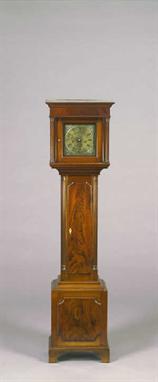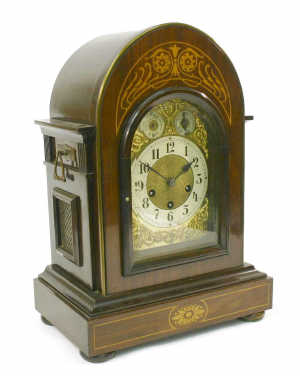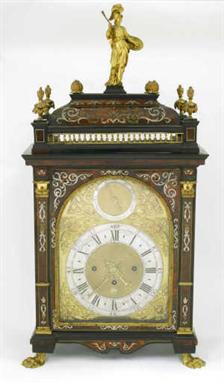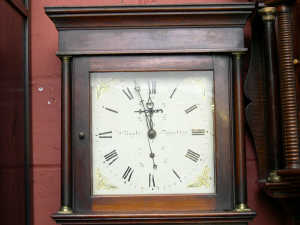A Mahogany Striking Bracket Clock, circa 1840, the arched case with inlaid front, carrying handles and brass sound frets to the sides, ball feet, 8-inch white painted convex dial with Roman numerals, strike/silent lever at 12, moon hands, twin fusee movement with anchor escapement and rack striking on bell, backplate with floral engraved border, movement secured by two brackets, 41cm high
We found 28112 price guide item(s) matching your search
There are 28112 lots that match your search criteria. Subscribe now to get instant access to the full price guide service.
Click here to subscribe- List
- Grid
-
28112 item(s)/page
A William IV Brass Inlaid Mahogany Striking Bracket Clock, the break arch case top with brass handle, sound frets to the sides, the base with reeded decoration, 8-inch painted dial with Roman numerals, twin fusee movement with anchor escapement and striking on a bell, 46cm high to hilt of handle, together with a mahogany and ebony inlaid associated wall bracket, 40cm high
A William IV Mahogany Bracket Clock, with Pull Repeat, signed Arnold, 84 Strand, 446, with arched case carved with acorns, oak leaves and husks, rectangular base of good colour and a central recessed panel upon shaped feet, 6-inch painted dial with Roman numerals, twin fusee movement with anchor escapement and striking on a bell, dial and movement signed, 46cm high
An Ebonised Bracket Clock Timepiece, signed Allam & Clements, London, circa 1770, the ebonised case with breakarch top and brass handle, the sides with glazed panels and pierced frets to the front, bun shaped feet, 7-inch circular silvered dial, blued steel hands, single fusee movement with verge escapement, backplate signed "Allam & Clements, London", movement secured by two brackets, 36cm high to hilt of handle
A Regency Mahogany Striking Bracket Clock, signed John Morse, West Cowes, case with brass handle to a breakarch top, pierced brass sound frets to the front and sides, 8-inch circular white painted dial with Roman numerals, steel spade hands, twin fusee movement with anchor escapement strike on a bell, backplate border with engraved decoration, 44cm high
A Small Mahogany Longcase Clock, circa 1890, the case with flat top and fluted columns, trunk door of good colour and flanked by inset fluted pilasters, plinth with raised panel upon bracket feet, 8-inch square brass dial with Roman chapter ring, dial centre with engraved floral decoration, four pillar movement with anchor escapement and rack striking on a bell, 171cm high
An Oak and Mahogany Eight Day Longcase Clock, signed Rowntree, York, circa 1820, case with swan neck pediment, case with later inlay decorated with birds and flowers, wavy shaped trunk door flanked by fluted pilasters, rectangular inlaid plinth upon bracket feet, 13-inch arched painted dial signed "Rowntree, York", dial centre with subsidiary dials for seconds and date, four pillar movement with anchor escapement and rack striking on bell, 219cm high
A 19th century oak longcase clock, the hood with broken swan neck pediment and fluted Ionic columns above an ogee arched long trunk door, box base and bracket feet, the brass dial with moonphase to the arch and gilt spandrels, the silvered dial with Roman numerals, calendar dial inscribed 'Blaylock, Longton', the 30 hour movement striking on a bell, 220 cms high.
A 19th century mahogany longcase clock, the hood with broken swan neck pediment, central globe finial and rope twist columns above a short trunk door box base and bracket feet, the 30.5 cms dial painted with a ruin to the arch and similar spandrels, with Roman numerals, seconds subsidiary dial and calendar aperture, inscribed, the eight day movement striking on a bell, 225 cms high..
An early 20th century oak cased bracket clock, the domed top with gilt figure surmount above a rectangular body and plinth decorated with gilt metal flowers, on gilt metal scrolling feet, the arched dial with silvered chapter ring and Roman numerals inscribed 'Kaiser Cardiff', together with subsidiary slow/fast and chime/silent dials, the spring barrel movement with repeat mechanism striking on gongs, 58 cms high..
ROBERT WARD, LONDON A George III mahogany bracket clock, the musical movement striking on bells, the domed case with glazed door enclosing an arched silvered dial, with dial to the arch for 'Jigg/Minuet/Jigg/Air', engraved arch and spandrels, on plinth base with ebonised block feet 42.5cm high
WIELAND, WATWORTH A Regency mahogany and brass inlaid bracket clock, the movement striking on a bell, the stepped gadrooned rectangular top with gilt brass pineapple finial, above a glazed circular enamel dial, and brass inlaid apron, lion's head mask handles to the sides, gilt brass ball feet 48cm high
THOMAS HAMPTON, WREXHAM A George III oak eight-day long case clock, later carved overall in low relief, the twin train movement with anchor escapement striking on a bell, the hood with swan neck pediment centred by brass ball and eagle finial, above glazed door enclosing arched brass dial, with subsidiary seconds dial and date aperture, cast spandrels and maker's name to the arch, between fluted columns, the case with trunk door between fluted quarter column angles, on panelled base with bracket feet 234cm high
A fine Cheshire figured mahogany eight-day longcase clock with moonphase, circa 1780, the four-pillar rack and bell striking movement with 13.5 inch brass Roman numeral break-arch dial, with subsidiary seconds dial and calendar aperture to the foliate scroll engraved silvered centre, within silvered chapter ring and foliate scroll spandrels beneath moonphase and signature 'Samuel Clare, Hatton' to arch, in swan neck pedimented case with verre eglomise infill and fluted pilasters to hood over blind fret decorated throat and shaped-top bookmatch veneer trunk door flanked by quarter columns, on raised panel applied plinth base with canted angles and ogee bracket feet, 252cm high..
An inlaid mahogany eight-day longcase clock, circa 1800, the four-pillar rack and bell striking movement with 14 inch Roman numeral brass break-arch dial, with subsidiary seconds to the urn and scroll engraved silvered centre signed 'Jno' Fletcher, Barnsley', with female head pattern spandrels and silvered 'Tempus Fugit' boss to arch, in a swan neck pedimented case with turned hood pilasters and fleur de lys centre shaped-top trunk door flanked by inlaid pilasters, on plinth base with bracket feet, 233cm high.
A Midlands oak and mahogany eight-day longcase clock, circa 1790, the rack and bell striking four-pillar movement with 12 inch single sheet Roman numeral engraved brass break-arch dial, with arched calendar aperture and subsidiary seconds dial to the scroll decorated centre, with conforming spandrels and signed 'Henry Payton, Bromsgrove' to the arch, in a swan neck pedimented line inlaid case with reeded hood pilasters over conch shell patera centred rectangular trunk door and plinth base with squat bracket feet, 228cm high. Henry Payton is recorded in G H Baillie 'Watchmakers and Clockmakers of the World' as working in Bromsgrove circa 1765.
A rare George III Bristol mahogany regulator, circa 1785, the four-pillar eight-day single train movement with deadbeat escapement, bolt and shutter maintaining power and long crutch, the 12 inch square silvered dial with Arabic minute numerals and later hour sector over signature 'William Hewlett, Bristol' to centre, in swan neck pedimented case with plain hood pilasters, rectangular trunk door and on plinth base with bracket feet, alteration to movement, 208cm high. See lot 382 for a High Water at Bristol Key longcase clock by his father.
A brass mounted inlaid rosewood quarter chiming eight-day bracket clock, circa 1900, the Junghans three-train gong-striking movement with 6 inch arched brass dial with silvered Arabic numeral chapter ring, foliate spandrels and subsidiary Chime/Silent, Fast/Slow dials to arch, in brass edged arch-top case with stylised foliate inlaid crest to arch, pierced brass side frets and rosette centred plinth base with squat bun feet, 45cm high.
A French Empire patinated bronze mounted oak eight-day mantel clock, circa 1830, the bell-striking movement with silvered Roman numeral dial set into foliate scroll pedimented rectangular pedestal beside finely cast figure of Minerva with cornucopia, on medallion and trophy centred festoon applied plinth base with leafy bracket feet, case probably originally marble, 49cm high.
A Leicester mahogany eight-day longcase clock with moonphase circa 1770, the substantial four-pillar rack and bell striking movement with star wheel set-up and 12 inch brass break-arch dial applied with Roman numeral chapter ring with Arabic minutes and rococo scroll spandrels, the centre with arched calendar aperture, ringed winding holes and signed 'Edw. Shepherd, Leicester' to a rococo scroll bordered cartouche, with moonphase within scroll engraved border to arch, in a pagoda top case with fluted hood pilasters, break-arch trunk door flanked by reeded canted angles, on panel decorated base with bracket feet, 224cm high.
A George III eight-day ebonised musical bracket clock circa 1790, the twin fusee back-wound movement with verge escapement and playing a choice of three airs on eight bells, the backplate engraved with fleur de lys within an oval cartouche and foliate borders, the 8 inch break-arch single sheet silvered Roman numeral dial with foliate engraved spandrels and signed 'George Howard, London' to centre, the arch with blued steel tune selection hand for 'Song', 'Minuet' and 'Jigg' with urn and foliate scroll engraved infill, in an ebonised bell-top case with brass carrying handle, arched side windows and on block feet, 49cm high excluding handle.
A Swiss Neuchatel style eight-day bracket clock in the Louis XV taste with bracket en suite, 20th century, the bell-striking movement with white Roman numeral enamel dial, with ball finial and gilt mouldings to the floral painted ebonised waisted case with glazed aperture beneath dial, on scroll feet, with ogee wall bracket en suite, 68cm high overall.
A Somerset mahogany cased thirty-hour longcase clock circa 1725, the two handed four-pillar outside countwheel bell-striking movement with 10.75 inch square brass dial applied with Roman numeral chapter ring with Arabic minutes and cruciform half hour markers, London Cherub head pattern spandrels, the matted centre with square calendar aperture beneath bridge signature plaque 'William Cuff, Wells', in a later swan neck pedimented case with wavy edge hood door, square trunk door and plain base with bracket feet, distressed, 208cm high.
An impressive French gilt metal mounted boulle 'Religieuse' bracket clock, circa 1680, now with substantial English eight-day seven-pillar triple fusee verge bracket clock movement circa 1780, chiming the quarters on six bells and striking the hour on a larger bell, with gilt brass full-arch dial applied with silvered Roman numeral chapter ring with Arabic minutes, diamond half hour markers and London Cherub head spandrels, the matted centre with calendar aperture and the arch with rise/fall regulation dial flanked by dolphin mounts, with fine original engraved gilt brass hands, in inverted bell-top case with finely chased gilt brass figure of Minerva between two tiers of finials with openwork baluster gallery beneath, the front with Corinthian pilasters and shaped apron, the sides with tall rectangular windows, the whole with fine premier-parti pewter and brass foliate scroll decoration on a mottled real shell ground and fine ebony mouldings, on four gilt hairy lion paw feet, 79cm high.
A fine Bristol mahogany eight-day longcase clock with 'High Water at Bristol Key', circa 1750, the four-pillar rack and bell striking movement with 12 inch brass break-arch dial applied with silvered Roman numeral chapter ring with Arabic minutes and signed 'Isaac Hewlett, Bristol' along lower edge, with rococo scroll and cockleshell spandrels, the matted centre with subsidiary seconds ring and calendar aperture, with moonphase to arch calibrated for tidal times to upper edge, the fine case with ogee moulded caddy and cornice over integral hood pilasters and shaped-top parquetry line inlaid trunk door, on conforming plinth base with bracket feet, 245cm high. A regulator by his son, William, is also offered in this sale as 291.
AN EARLY 19TH CENTURY OAK LONG CASE CLOCK, with thirty hour movement, the square painted dial with roman numerals and calendar aperture, the square hood with fret cut pediment and turned finials and angle pillars, the trunk with long rectangular door, the plain base on bracket feet. Dial Width 12". Width 13". Height 80".
AN EARLY 19TH CENTURY OAK LONG CASE CLOCK, with eight day striking movement, the arched painted dial with arabic numerals, second and calendar dial and inscribed "Fox Beverley", the domed hood with turned wooden finials, blind fret and fluted angle pillars, the trunk with long shaped door, the cross banded base on bracket feet. Dial Width 12". Width 13". Height 94".
A Victorian mahogany crossbanded longcase clock, circa 1870 the broken scroll pediment centred by a pyramid finial above an arched glazed door flanked by wrythen reeded columns and enclosing 14" white painted arched enamel dial with roman numerals, subsidiary seconds dial and moon phase in the arch, and marked 'E Lashmore, Oswestry', painted with rustic housing and castle ruins to the corners and arch, eight-day movement striking on a bell above a three-quarter length shaped arched top crossbanded trunk door, flanked by wrythen reeded columns over a crossbanded panel, canted border and crossbanded base board and raised on ogee bracket feet, 90" high.
A George I repeating bracket clock by Joseph Windmills, the twin fusee movement striking on six bells, the engraved back plate inscribed 'Jos Windmills, London', to an engraved brass arched dial with silvered chapter ring and subsidiary date dial, the matted centre inscribed 'J Windmills, London', the ebony veneered case with gilt brass mounts, the double basket top with finials, side carrying handles, on paw feet, 24.25in (61.5cm) h.
A Regency brass inlaid mahogany repeating 8-day bracket clock, maker Wm Moon of 4 Holborn Bars, London, mounted with pineapple finial on sarcophagus shaped top and ripple moulded cornice above a circular white enamel Roman numeral dial, enclosed by floral spandrels, the movement striking on a bell, on brass ball feet, 48cm high, 29cm wide, 17cm diameter
An early 19th century mahogany longcase clock, the hood with projecting cornice above a square glazed door flanked by columns, the long trunk door above projecting box base, on tapered bracket feet, the eleven inch square painted dial inscribed 'W. Bleale(?), Brighton', decorated in gilt with flowers to the spandrels, the single train brass movement with anchor escapement striking on a bell, 197.5cm high, 47cm wide
A George III mahogany longcase clock, the hood with flower carved swan neck pediment and leaf scroll decorated eglomise panels, above an arched glazed door flanked by fluted columns, the ogee arched long trunk door flanked by reeded pilasters, above a panelled box base with chamfered corners, on ogee bracket feet, the fourteen inch painted dial signed 'Collier, Cheadle', with subsidiary seconds and date dials, within Roman hour and Arabic minute numerals, with flower painted spandrels, the arch with moonphase, the twin train brass movement with anchor escapement, striking on a bell, slight faults and restorations, approximately 230cm high
MARMADUKE STORR, LONDON: A George III mahogany bracket clock, the circular silvered dial signed to the centre, with date aperture, the chapter ring with Roman numerals with strike/silent selector above, the door with brass mounts and gilt cast spandrels, the case with raised top and cast carrying handle, the twin fusee five pillar movement with verge escapement and elaborately engraved back plate and brackets, with pull repeat, 18" high.
JAMES WARNE, LONDON: A George III mahogany bracket clock, the silvered chapter ring with matted centre with visible pendulum bob and date aperture, the chapter ring with Roman numerals and Arabic minutes, with cast and pierced spandrels to the corners with strike/silent indicator above, the door with arched topped panel and further conforming spandrels, the case with raised carrying handle and fir cone finials, the twin chain fusee movement with verge escapement and elaborately engraved back plate, with pull repeat, 21" high.
Ebonised striking bracket clock, William and Mary with restorations, and replacements, pierced brass basket top and flame finials, brass repousse door mounts, square dial, 7ins "Gorsuch Salop", silvered chapter ring, malted centre with ringed winding hole, dale aperture, false pendulum aperture, winged cherub spandrels, blued hands, four pillar, single fusee movement with verge escapement, pull quarter and hour repeat on two bells, back plate engraved and named Thomas Garsuch in Salop. Height 41cms
Mahogany long cased clock, two train movement striking on a bell, Owen plate, broken arch painted face with rolling moon and four, spandrels, second dial and date aperture, "Wm Bucknall, Burslem" in inlaid mahogany case with swans neck hood, fluted columns, arched door and canted corner base on ogee bracket feet. Height 231cms, 91ins (2 weights, pendulum, key)
A French tortoiseshell and gilt metal mounted bracket clock, the waisted case with cut brass inlay, foliate mounts and putti finial, glazed side panels, on scroll feet, the cast dial applied with white enamel Roman numerals and signed 'Gouchon, a Paris', the twin barrel movement with outside countwheel striking to a bell, and the wall bracket en suite, 79cm. total height.
AN EBONISED BRACKET CLOCK dial: 7inch silvered chapter ring, central alarm ring, the brass face engraved Tho. Tompion, movement: anchor escapement and two pulls, the back plate also engraved Tho. Tompion, London Fecit, case: engraved with carved stiff foliage,gilt metal folaite basket top, 19in. (48cm.) high
A George IV mahogany bracket clock in the Egyptian style, the enamelled circular dial signed D & W MORICE Fenchurch Street LONDON, with roman chapters and pierced brass hands, the twin fusee movement striking on two bells and signed again on the shaped backplate, the case with a turned finial and fluted pediment between acroteria and with ebonised mouldings, on reeded feet, 55cm h The partnership of David and William Morice lasted from 1818 to 1838. Small filled chip adjacent to one of the winding holes but in overall excellent condition and of finely figured veneers. Minor loss and repaired loss to the acreteria and the side frets. The movement complete and original. In apparently good going order
-
28112 item(s)/page













































